基础医学英语-山东大学
(完整版)医学专业英语词汇
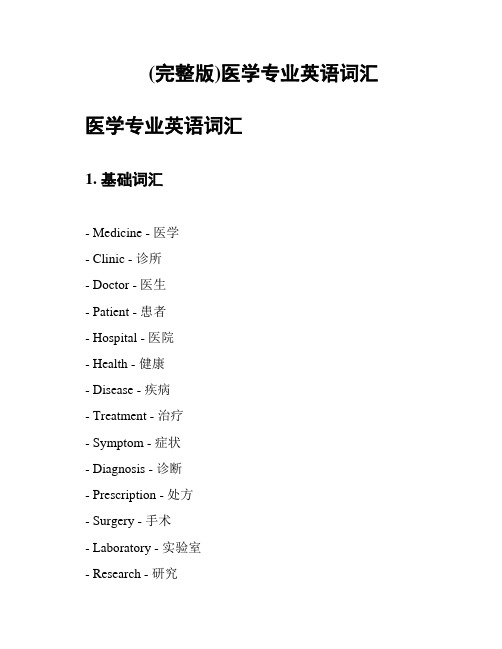
(完整版)医学专业英语词汇医学专业英语词汇1. 基础词汇- Medicine - 医学- Clinic - 诊所- Doctor - 医生- Patient - 患者- Hospital - 医院- Health - 健康- Disease - 疾病- Treatment - 治疗- Symptom - 症状- Diagnosis - 诊断- Prescription - 处方- Surgery - 手术- Laboratory - 实验室- Research - 研究- University - 大学- Medical - 医疗的- Nurse - 护士- Pharmacist - 药剂师- Therapist - 治疗师- Vaccine - 疫苗- X-ray - X光片- HIV - 人类免疫缺陷病毒- Cancer - 癌症- Diabetes - 糖尿病- Heart - 心脏- Kidney - 肾脏- Liver - 肝脏2. 解剖学词汇- Anatomy - 解剖学- Skeleton - 骨骼- Muscle - 肌肉- Nervous system - 神经系统- Digestive system - 消化系统- Respiratory system - 呼吸系统- Circulatory system - 循环系统- Skeletal system - 骨骼系统- Muscular system - 肌肉系统- Nervous tissue - 神经组织- Respiratory tract - 呼吸道- Circulatory system - 循环系统- Digestive tract - 消化道- Central nervous system - 中枢神经系统- Peripheral nervous system - 外周神经系统- Endocrine system - 内分泌系统- Urinary system - 泌尿系统3. 疾病词汇- Infection - 感染- Allergy - 过敏- Fever - 发烧- Inflammation - 炎症- Pain - 疼痛- Cough - 咳嗽- Headache - 头痛- Fatigue - 疲劳- Depression - 抑郁症- High blood pressure - 高血压- Arthritis - 关节炎- Asthma - 哮喘- Alzheimer's disease - 阿尔茨海默病- Stroke - 中风- Multiple sclerosis - 多发性硬化症- Pneumonia - 肺炎- Cancer - 癌症- Diabetes - 糖尿病- Heart disease - 心脏病- Kidney disease - 肾脏疾病- Liver disease - 肝脏疾病- Sexually transmitted disease - 性传播疾病4. 检查和测试词汇- Blood test - 血液检查- Urine test - 尿液检查- X-ray - X光检查- Ultrasound - 超声波- MRI (Magnetic Resonance Imaging) - 磁共振成像- ECG (Electrocardiogram) - 心电图- PET scan (Positron Emission Tomography) - 正电子发射断层扫描- Colonoscopy - 结肠镜检查- Pap smear - 涂片检查- Biopsy - 活检- Lymph node biopsy - 淋巴结活检- Bone marrow biopsy - 骨髓活检5. 药物相关词汇- Medication - 药物- Drug - 药品- Prescription - 处方药- Over-the-counter (OTC) - 非处方药- Antibiotics - 抗生素- Analgesics - 镇痛药- Antidepressants - 抗抑郁药- Antipyretics - 退热药- Antihistamines - 抗组织胺药- Anticoagulants - 抗凝药- Opioids - 麻醉药- Diuretics - 利尿药- Antivirals - 抗病毒药- Anti-inflammatory - 抗炎药- Beta blockers - 贝塔受体阻滞剂- Statins - 他汀类药物- Vaccines - 疫苗- Insulin - 胰岛素- Cholesterol-lowering drugs - 降低胆固醇药物以上是医学专业英语词汇的一部分,希望对您的学习和工作有所帮助。
医学英语第三册(MedicalEnglishthirdvolumes)

医学英语第三册(Medical English third volumes)Possess, V. yes, have; masterMagical adj. has magic, magicalAssume v. assumes, assumes, assumesLink, N. contact, connectionOptimist n. optimistsView v. look, think, observeIn a blue mood is in a bad moodProfound, adj., deep, profoundElectromagnetic, adj., electromagneticBeholder n. viewers, witnessesPsychologist n. psychologistElicit, vt., cause to issueStir v. to move or excite; stirPatriotism, N., patriotism, patriotismAffection n. gentle, dearAntidote n. correction method, antidote Raise v. feeding, tendingRainbow n. rainbowSpectrum n. spectraA, spectrum, of, continuous, serial Startling adj. is amazingFlash n. flash, a sudden shotAlga n. algaeMate v. matingInterior, adj., interior, interior Decorator n. house decoration people Illumination n. lighting; lighting fixtures Nearsighted, adj., near sightedBlurry adj. blurred visionWear, v., wear, wearGlasses n. glassesAt arm's length arm can reach near.What is called, so called... TheAstigmatism n. astigmatismCorrect, V. correction, correction, correction Cataract n. cataractFaint adj., obscure, darkCloudy adj. fuzzy; cloudyBe accustomed to is used toRather than (Ning)... Rather than...Camera cameraOpening n. openingAdjust v. regulation; adjust and tidy up Diaphragm n. aperture, light barPupil n. pupilPhotograph, v., take picturesIndistinct adj. is not clearClose by, not far from hereDistance n. distance; distanceSpeck n. spots; stainsRelax vt. relax and relaxNow, and, then sometimes, from time to time Concentrate v. concentrate strength or attention on Complicated, adj., obscure, obscure Unacquainted, with, yeah... Not familiar withAngle n. angleRetain, v., keep, keep; keepMoving picture moviesSuccession, N. continuous, successive, continue Fraction n. part, fragmentScreen, N. screen, screenJumpy, adj., neuroticFashion n. look, the wayTeenager n., 13 to 19 year old young manComment n. comments; explanations; explanations Creative, adj., creativeImaginative, adj., fancyLogic, N., logic reasoning, logicEducated, adj., educatedSyllabus n. syllabus; curriculum scheduleItem n. items, termsBalance VI. & vt. balance and balance state; n. scale Episode n. event; episodeVivid adj.; vivid; brightRevision n. review, review, revisionRevise v. review, review, revisionPhenomenon n. phenomenonTechnology n. technology, technology Meaningful adj. has profound meaning Statistics, N. statistics, statistics Demography n. demographic statistics Census, N. demographics, censusYearbook n. YearbookWork out worked out; the results worked Infanticide n. infanticideStarvation n. starve, starve to death Typical adj. typical and representative Tribal, adj., clan, clanUniversal adj. universal, consistent Explosion n. explosion; explosion, explosion More or less more or less; left and right Transitional, adj., transition, transferred Distinctive adj. has its own featuresProductivity, N. production capacity, productivity Primitive adj. primitive; simpleAgriculture, N., agriculture, agronomyProductive adj. rich; produce... TheSophisticated adj.; sophisticated; sophisticated Applicable ad.; appropriate; applicableFertility, N., fertility, fertilityStabilize, v., stability, stabilityMortality n. death number; mortalityDecline, N., decline, declineAnnual, adj., year, yearBillion n. (UK) trillion; (beauty) one billion Inflation n. inflationTag n. tags, tagsReplace v. put it back in placeCompete, v., competition, competitionCat computed tomography scanScanner n. scannerDialysis n. dialysisInvestment n. investment; investmentCompetition n. competition; competitionLicence v. issued a licenseBoard n. Committee, Council, BureauTrend, N. trends, tendenciesSpecialization n. specialization and specialization Primary care was initially treated with primary treatment General practice general practitioner, family doctor Specialty n. majorInner, adj., internal, includedPediatrics n. PediatricsCardiologist n., a heart specialistCrisis n. turning point; shock; crisisCritic n. critics; a criticEarn v. earned, earnedIncome n. revenueMake, up, for compensation, make upEarnings income, income salaryInsurance n. insurance premiumLegal adj. legalOrthopedics n. orthopedic bone, bone; Science Malpractice n. misconduct; dereliction of duty Regardless of ignores; regardless of disregard Costly, adj., expensive, expensiveGallbladder n. gall bladderGreed, N., greed, greedIncentive, N., stimulation, seductionProfit n. profit; benefitDense adj.; dense; denseFog n. fog, fog, confusionValley, N. valleys, valleys, watersheds Belgium n. BelgiumFoggy adj. foggy; obscureStrain v. straining; striving, striving Chemical, N., chemicals, chemicalsMilky, adj., milk, milkRoll v. scrollFurnace, N., furnace, furnace, blast furnace Inversion, N. reverse, inverted, inverted Lid n. lids; lids; hatsPile, up, heaps, heapsSoot, N. soot, sootAirport n. airport, air terminalA chain of chain n.; chains; collars Collision n. collisionHighway n. highway, main roadLos Angeles Los AngelesSting, v., sting, stingPhotochemical, N., light emitting chemicals Nitrogen n. nitrogenOxide n. oxideRefinery n. refinery; refineryProhibit v. prohibited; blockedChimney n. chimney, chimneySun-powered adj. solar poweredEngine n. engines, enginesSolar, adj., sun, daylightDevice n. design, device, planPower v. powered by powerSatellite n. satellite; man-made satellite Capture, V. capture, capture, capture Chlorophyll, N., chlorophyllStarch n. starch; starchy foodGlycogen n. animal glycogen, starchEyebrow n. eyebrows, eyebrowsOverheat, V. heating too large, over heating Clap v. clap your handsChilly adj. cold; unfriendlyShiver, v., trembling, tremblingBundle n. bundles; packages; parcelsScatter v. scatter; scatter; scatterBiceps n. two muscleThumb n. (big) thumbRegiment n. regiment; a large crowdMessage, N., communications, messages, information Relay v. split delivery; retransmissionInstantly ad. immediately, instantlyInvoluntary adj. is optionalAutonomic, adj., autonomous, spontaneousRout v. (delivered by a certain route)Radar n. radar, radio detectorBombard, v., bombardment, bombing, collision Hourly adj. & ad. per hourRecoil v. back, back to back;Gravity n. gravityJerk v. jerked; muscle contractionFlex v. buckling (limbs)Rectangle n. rectangle, rectangleIris n. iris; rainbowReceptors for receptor, N. receptorsBack, and, forth, come and goFeed v. supply... Give, feed (raise)Sort v. put... classificationFile v. put... FileBud, n. (Jie Pou) bud, bud; budOptic, adj., ocular, visualRadiate v. emission (light or heat), radiation Skyscraper n. skyscraperPuberty n. pubertySomatic adj.; somatic; parietalPrecede v. precedes... Ratio... first Trigger, v., cause, exciteHypothalamic adj. in the hypothalamus Pubescent adj. pubertyThe sudden explosion of spurt n. burst forth遇到诉遭遇,遇到身材,身高,身材值得注意的。
基础医学英语_Fundamental_Unit_3-文档资料

《基础医学英语》
中国海洋大学出版社
任课教师:山东大学 戈立
geli@
Teaching Set-up
This course is conducted on a one-unit-a week basis preceded by a general introduction to medical English in the first week of the school term.
1. Word Formation 2. Group Discussion 3. Background Knowledge 4. Understanding the Text 5. Assignment
Unit 3 The Nervous System
Word Formation
neur/o- 神经 ( neuron, neurofibril )
pre- 在前 post ganglionic ) enter/o- 肠 ( enteric ) dendr/o-, dendri- 树 ( dendritic ) axo- 轴, 轴突 ( axon )
medull/o 髓质 ( medulla ) cyt/o, -cyte 细胞 ( cytoplasm ) mito- 线 ( mitochondrial ) -ule (使小后缀) ( spinule, tubule )
necle/o 核
( nucleus )
gangli/o-, ganglion/o- 神经节
( ganglia )
gli/o- 胶, 胶质 ( neuroglia )
peri- 周, 周围 ( peripheral )
综合医学英语(研究生、期末考试、总结)
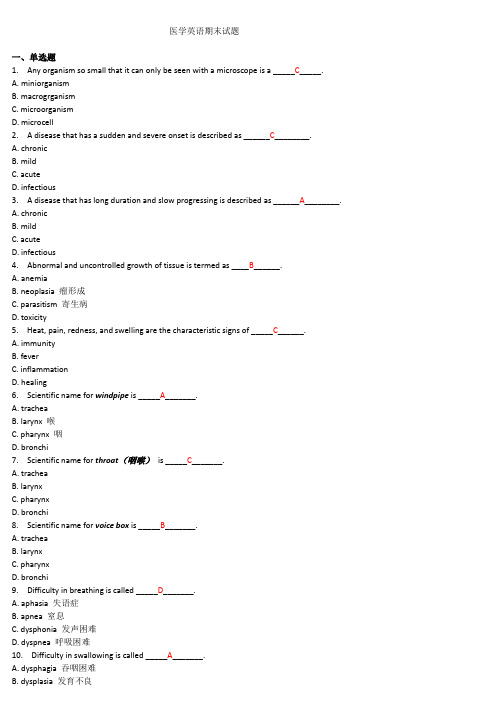
医学英语期末试题一、单选题1. Any organism so small that it can only be seen with a microscope is a _____C_____.A. miniorganismB. macrogrganismC. microorganismD. microcell2. A disease that has a sudden and severe onset is described as ______C________.A.chronicdC.acuteD.infectious3. A disease that has long duration and slow progressing is described as ______A________.A.chronicdC.acuteD.infectious4. Abnormal and uncontrolled growth of tissue is termed as ____B______.A.anemiaB.neoplasia 瘤形成C.parasitism 寄生病D.toxicity5. Heat, pain, redness, and swelling are the characteristic signs of _____C______.A.immunityB.feverC.inflammationD.healing6. Scientific name for windpipe is _____A_______.A.trachearynx 喉C.pharynx 咽D.bronchi7. Scientific name for throat(咽喉)is _____C_______.A.trachearynxC.pharynxD.bronchi8. Scientific name for voice box is _____B_______.A.trachearynxC.pharynxD.bronchi9. Difficulty in breathing is called _____D_______.A.aphasia 失语症B.apnea 窒息C.dysphonia 发声困难D.dyspnea 呼吸困难10. Difficulty in swallowing is called _____A_______.A.dysphagia 吞咽困难B.dysplasia 发育不良C.dysphoniaD.dyspnea11. A word element from which other words are formed is called _____C_______.A.prefixB.suffixC.rootbining vowel12. A word part at the beginning of a word is a (n)____D______.A.originbining formC.previewD.prefix13. A word part at the end of a word is a(n)_____C_____.A.vowelbining formC.suffixD.insertion14. The opposite of hypertension is ____C______.A.hypoglucemiaB.hyperglucemiaC.hypotensionD.hyperglycemic15. The prefix in the words prefix and pretest means _____A______.A.beforeB.finalC.fixedD.superior16. The gh in the terms cough and radiograph is pronounced as ______C_______.A.gB.hC.fD.t17. The pn in the term pneumonia is pronounced as _____D________.A.pB.hC.fD.n18. The suffixes-ia, -sis, and -ism all refer to _____A_______.A.condition ofB.disease ofC.problem ofD.specialty of19. The plural of serum is _____B_______.A.serumsB.seraC.seriaD.serina20. The singular of thrombi is _____B_______.A.thrombB.thrombusC.thrombsD.thrombis21. The suffixes -sis, -ian,and -ics are found in ____D____.A.verbsB.adjectivesC.adverbsD.nouns22. The suffixes-ic, -ous, and -al are found in ____B____.A.verbsB.adjectivesC.adverbsD.nouns23. CT stands for computerized tomography. This term represents a (n) ____B______.bining formB.acronym 首字母缩略词C.synonym 同义词D.clipping24. A dentist is a physician who specializes in study of ___A___.A.teethB.skeletonC.skinD.stomach25. Which branch of medicine is concerned with diseases of the kidneys? _____C_____A.psychologyB.pulmonologyC.nephrologyD.neurology26. A term for inflammation of the lungs is ______B______.A.bronchitisB.pneumoniaC.pleurisy 胸膜炎ryngitis27. An endotracheal tube is placed ______A________.A.within the tracheaB.beyond the tracheaC.under the tracheaD.over the trachea28. A gastroenterologist is a physician who specializes in study of _________B__________.A.mouth and teethB.stomach, intestines, and related structuresC.musculoskeletal systemD.respiratory system29. A general term for inflammation of a joint is ______A________.A.arthritisB.conjunctivitis 结膜炎C.epididymitis 附睾炎D.myocarditis30. Chondrosarcoma is a tumor that originates in _____D_______.A.boneB.muscleC.tissueD.cartilage31. A tonsillectomy is _____C_______.A.removal of a jointB.removal of a tumorC.removal of a tonsil 扁桃体D.removal of a cavity32. The neuromuscular junction is between a muscle and a _____B_______.A.glandB.neuronC.boneD.gonad33. Polymyositis is inflammation of many _____C_______.ansB.glandsC.musclesD.bones34. The term for a condition or disease of unknown etiology(病原学)is _____D_______.A.hypertrophic 肥厚的B.chronicC.acuteD.idiopathic35. Death of tissue is called ______A______.A.necrosis 坏死B.inflammationC.infectionD.spasm 痉挛36. The cervical region is the region of the ____D______.A.brainB.legC.HeartD.neck37. Difficulty in digesting is called ______C______.A.apepsia 不消化B.eupepsia 消化良好C.dyspepsiaD.dysphonia38. The quadriceps muscle group(四头肌)is made up of _____B_______.A.smooth and cardiac muscle fibersB.four muscles in the thighC.three muscles in the legD.fascia筋膜and tendon sheaths腱鞘39. The control center of the cell is the ____D____.A.membraneB.lysosome 溶酶体C.ribosome 核糖体D.nucleus40. A simple device for listening to sounds within the body is a ____B____.A.cystoscope 膀胱镜B.stethoscope 听诊器C.barometer 气压计D.speculum 窥器41. Removal of tissue for microscopic study is a(n) ____A____.A.biopsyB.aeration 通气C.endoscopyD.CT scan42. Hepatosplenomegaly means ____D____.A.removal of the liver and spleenB.prolapse下垂of the liver and spleenC.hemorrhage of the liver and spleenD.enlargement of the liver and spleen43. The cardiovascular system includes the heart and ____C____.A.lungsB.digestive organsC.blood vesselsD.endocrine system44. Erythrocyte is the scientific name for a ____B____.A.white blood cellB.red blood cellC.lymphocyteD.muscle cell45. Leukocyte is the scientific name for a___A____.A.white blood cellB.red blood cellC.lymphocyteD.muscle cell46. A deficiency of hemoglobin results in the disorder called____C____.A.hypertensionB.chromatosis 色素沉着C.anemiaD.hemophilia 血友病47. A neoplastic overgrowth of white blood cells is called ____A____.A.leukemiaB.anemiaC.fibrosisD.cystitis 膀胱炎48. The gas that is supplied to tissues by the respiratory system is ____C____.A.sulfur 硫磺B.neon 氖C.oxygenD.carbon dioxide49. The gas that is eliminated by the respiratory system is ____D____.A.sulfurB.NeonC.OxygenD.carbon dioxide50. The tubes that carry air from the trachea into the lungs are the ____D____.A.arteriesB.Nares 鼻孔C.VeinsD.bronchi二、完形填空Part II ClozeThe problem of caring for the weak and sick has existed from the earliest times. The Romans, in times of war, established infirmaries,51 were used to treat sick and injured soldiers. Later on, infirmaries were founded in the larger cities and were built out of public52 .In a way, the Roman influence was53the establishment of hospitals.54 Christianity grew, the care of the sick became the duty of the Church. The monasteries and convents provided most of the hospitals. The custom of making pilgrimages (朝圣) also helped advance the55 of hospitals. Those pilgrimages were often long, and the travelers had to stop overnight at small inns56 the road. These inns were called hospitalia, meaning a guest. The inns connected with the monasteries devoted themselves to caring for travelers who were ill or weary, and the name hospital became connected with caring for the57 .Since living conditions during the Middle Ages were not comfortable or hygienic, the hospitals were58 clean or orderly. In fact, many59 hospital would put two or more patients in the same bed.But it wasn't60 the eighteenth century that public hospitals became general in the larger towns of England. Soon, the idea of public hospitals began to spread and they appeared all over Europe.51. A. for whom B. in which C. which D. who52. A. funds B. affairs C. figures D. interests53. A. capable of B. respectful of C. accessible to D. responsible for54. A. With B. For C. If D. As55. A. tradition B.form C. Idea D. skill56. A. to B. from C. Across D. along57. A. afflicted B. affiliated C. addicted D.affirmed58. A. close to B. far from C. careful about D. considerate of59. A. a B. such C. other D. another60. A. in B. by C. up to D. until答案:51. C52.A53.D 54.D 55.C56.D 57.A 58.B 59. A 60.D三、阅读理解(一)The blue, mystic Lake Elsinore lies in an inland California valley which is teeming and steaming with hot springs. Rimmed by shaggy mountains whose forested crests are reflected in its clear waters, Lake Elsinoreis the very personification of peace—but on it rests the curse of Tondo.The lake has had a colorful history. Much of it lies buried in legend, and it is difficult to separate fact from fiction. There have been stories of underground volcanoes on the lake bottom, erupting, killing fish and discoloring the water. There have been stories of a playful sea serpent that lived in its depths.Long noted for its scenic beauty and health-giving waters, the lake was a famous resort in the Nineties. But long before the first white man had set foot along the shore of the lake, this part of California had been the home of the Soboba Indians. Their chief was Tondo, a stern and unforgiving man.He had a daughter, Morning Star, who was in love with Palo, son of the chief of the Palas, a neighboring tribe. The Sobobas and Palas were sworn enemies. For a time the lovers met secretly. Then one day they were discovered by Tondo. His rage was terrible to behold. He forbade the lovers ever to meet again.Morning Star tried in every way to appease her father’s anger, to soften his heart toward Palo. But in time she saw that it was useless; that he would never give his consent to their marriage. Vowing that they would never be separated, the Indian maid and her lover walked hand in hand into the lake, as the dreary November sun cast long shadows on the land. They were followed by a group of orphan children whom Morning Star had befriended. All walked into the lake, singing the mournful death song of their people, while Tondo stood on the shore and cursed the lovers, cursed the blue water into which they all walked to their death.Ever since that day it would seem that a jinx has been laid over Lake Elsinore. Oldtimers tell of a great upheaval in the lake which caused water to spout into the air like a geyser and turn blood-red. Later, it became known that three hundred springs of boiling mud and water were born in the valley during that upheaval. The springs reeked with sulphur.For many years after this phenomenon the lake remained peaceful. Then boats were overturned for no apparent reason, and few of their occupants ever returned to tell the story. This continued for several years. At the same time, strong swimmers dived into the lake never to reappear.In 1833 and again in 1846, fish in the lake suddenly died.In the spring of 1850 came the Battle of the Gnats. They bred in the water of the lake and swarmed over the land. They invaded the countryside until the harassed inhabitants called for help.And in July 1951, the sky-blue waters of the lake vanished like mist before a noonday sun. When the bottom was laid bare there was no trace of a volcano, the bottomless pits, or the other disturbances of legend or fact.The copious winter rains of 1951—52 have replenished the lake. But what menace does its haunting beauty hold today? For tomorrow?The once mighty Sobobas are few now. But the old men swear that their ancestors still haunt the lake. They nod grizzled head and murmur that the Great Tondo’s curse will forever remain upon the lake. Only time, the wise and silent one, can tell.61.Which of the following statements is true of Lake Elsinore?A. It is considered by legend to be rich in golb.B. It was once famous as a beautiful resort.C. It is located in a volcanic crater in California.D. It used to be the center of a mining village.62.Probably Tondo’s rage was due the fact that .A. Morning Star was too young to marryB. Tondo’s tribe and Palas’s tribe were enemiesC. Palo mistreated his Soboba girl friendD. Palas vowed meet Morning Star in secret63.According to the old-timers, on two occasions .A. the water of the lake turned redB. lake water sprouted into the airC. the Gnats invaded the countrysideD. fish in the lake suddenly died64.The word “jinx”(Line 1, Paragraph 6) probably means .A. spell of bad luckB. hot air currentC. strange tranquilityD. storm of unusual duration65.Which can be considered the best title for the passage?A. The Curse of Tondo.B. The Beautify Lake Elsinore.C. The Mysterious Indian Tribes.D. The Tragic Love of Morning Star.(二)Despite Denmark’s manifest virtues, Danes never talk about how proud they a re to be Danes. This would sound weird in Danish. When Danes talk to foreigners about Denmark, they always begin by commenting on its tininess, its unimportance , the difficulty of its language, the general small-mindedness and self-indulgen ce of their countrymen and the high taxes. No Dane would look you in the eye and say, “Denmark is a great country.”You’re supposed to figure this out for yo urself.It is the land of the silk safety net, where almost half the national budg et goes toward smoothing out life’s inequalities, and there is plenty of money f or schools, day care, retraining programmes, job seminars-Danes love seminars: t hree days at a study centre hearing about waste management is almost as good as a ski trip. It is a culture bombarded by English, in advertising, pop music, the Internet, and despite all the English that Danish absorbs—there is no Danish Academy to defend against it —old dialects persist in Jutland that can barel y be understood by Copenhageners. It is the land where, as the saying goes,“Fe w have too much and fewer have too little, ”and a foreigner is struck by the swe e t egalitarianism that prevails, where the lowliest clerk gives you a level gaze, where Sir and Madame have disappeared from common usage, even Mr. and Mrs. It’s a nation of recyclers—about 55 % of Danish garbage gets made into something new—and no nuclear power plants. It’s a nation of tireless planner. Trains run on time. Things operate well in general.Such a nation of overachievers —a brochure from the Ministry of Busines s and Industry says, “Denmark is one of the world’s cleanest and most organize d countries, with virtually no pollution, crime, or poverty. Denmark is the most c orruption-free society in the Northern Hemisphere. ”So, of course, one’s heart l ifts at any sighting of Danish sleaze: skinhead graffiti onbuildings(“Foreigne r s Out of Denmark! ”), broken beer bottles in the gutters, drunken teenagers slu mped in the park.Nonetheless, it is an orderly land. You drive through a Danish town, it co mes to an end at a stone wall, and on the other side is a field of barley, a nic e clean line: town here, country there. It is not a nation of jay-walkers. Peopl e stand on the curb and wait for the red light to change, even if it’s 2 a.m. a n d there’s not a car in sight. However, Danes don’t think of themselves as a w ai nting-at-2-a.m.-for-the-green-light people——that’s how they see Swedes and Ge r mans. Danes see themselves as jazzy people,improvisers, more free spirited than Swedes, but the truth is( though one should not say it)that Danes are very much like Germans and Swedes. Orderliness is a main selling point. Denmark has few n atural resources, limited manufacturing capability; its future in Europe will be as a broker, banker, and distributor of goods. You send your goods by container ship to Copenhagen, and these bright, young, English-speaking, utterly honest, highly disciplined people will get your goods around to Scandinavia, the Baltic States, and Russia. Airports, seaports, highways, and rail lines are ultramodern and well-maintained.The orderliness of the society doesn’t mean that Danish lives are less me s sy or lonely than yours or mine, and no Dane would tell you so. You can hear ple nty about bitter family feuds and the sorrows of alcoholism and about perfectly sensible people who went off one day and killed themselves. An orderly society c an not exempt its members from the hazards of life.But there is a sense of entitlement and security that Danes grow up with. Certain things are yours by virtue of citizenship, and you shouldn’t feel bad f o r taking what you’re entitled to, you’re as good as anyone else. The rules of th e welfare system are clear to everyone, the benefits you get if you lose your jo b, the steps you take to get a new one; and the orderliness of the system makes it possible for the country to weather high unemployment and social unrest witho ut a sense of crisis.66. The author thinks that Danes adopt a ___ attitude towards their country.A. boastfulB. modestC. deprecatingD. mysterious67. Which of the following is NOT a Danish characteristic cited in the pa ssage?A. Fondness of foreign culture.B. Equality in society.C. Linguistic tolerance.D. Persistent planning.68. The author’s reaction to the statement by the Ministry of Business a nd Industry is ___.A. disapprovingB. approvingC. noncommittalD. doubtful69. According to the passage, Danish orderliness ___.A. sets the people apart from Germans and SwedesB. spares Danes social troubles besetting other peopleC. is considered economically essential to the countryD. prevents Danes from acknowledging existing troubles70. At the end of the passage the author states all the following EXCEPT that ___.A. Danes are clearly informed of their social benefitsB. Danes take for granted what is given to themC. the open system helps to tide the country overD. orderliness has alleviated unemploymentANSER66-70 B A D C D四、Summary writing (写作)Directions:In this part there is an essay in Chinese.Read it carefully and then write a summary of 250 words in English on the ANSWER SHEET.Make sure that your summary covers the major points of the essay.通常,王华林的一天是这样的。
基础医学英语 PPT-
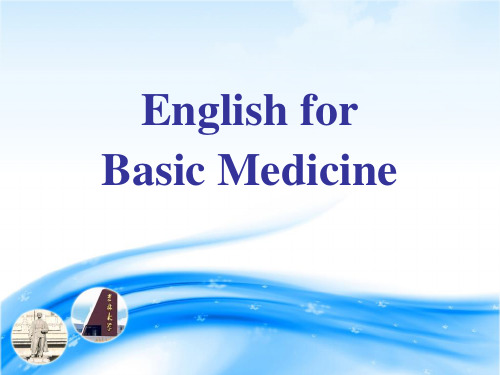
Latin roots refer to anatomy Greek roots refer to disease and treatments
8
Medical Language - history
2. Eponyms – words based on names of people
Parkinson’s disease Down’s syndrome Haversian canals Alzheimer's disease
ends, drop the final vowel from the root
Card i -o- itis
carditis
20
Combining Rule
Prefix attaches directly to the beginning of a word or root, combining vowel is not needed.
Example: carditis Suffix: itis = inflammation Word Root: cardi = heart Definition: inflammation of the heart
22
Analyzing & Defining Medical terms
Example: intracardiac Suffix: ac = pertaining to Prefix: intra = within Word Root: cardi = heart Definition: (pertaining to) within the heart
10
Compound Words
Compound words (合成詞) can be formed when 2 or more word roots are used to build the word If roots are words Word root + word root = Compound word Chicken + Pox = Chickenpox Brainstem, breastbone, collarbone, gallstone, gallbladder, fingernail download
基础医学英语

• well being/wellness---- n. health • alternate/alternative
Alternative Medicine ---- 替代医学
a wide range of treatments for medical conditions that people use instead of or with western medicine.
整体医学的发展概况
21世纪社会的发展以人为本,人的发展以健 康为本。人是一个不可侵害的有机整体,人所 需要的卫生服务是整体性的服务,要提高这种 服务必须树立整体医学观,掌握系统整体的思 维方式,开展生物-心理-社会医学模式,做好 以患者为中心而不是以疾病为中心的服务。
• 医学观就是医学工作者对医学的本质、构成和
• 美国整体医学主要表现替代疗法的常用
的十六种方法中,有5种属中医药学范畴, 日本整体医学界也十分重视中医学的各种 疗法。中医、中药、针灸、气功、推拿被 广泛应用于倡导整体医学的医院、诊疗所、 疗养院中,所以整体医学的崛起将给中医 药学的国际化带来机遇。
• 整体医学发展趋势
我国原有的卫生服务体系采用各种卫生服务 相互独立、各自为政、垂直管理的模式,分别由 相应的部门来管理,由专门的机构来实施,由不 同的专业人员来提供,相互之间缺乏协调和合作 ,难以实现横向整合,这种模式不能适应社会发 展的需要。医疗服务是一种整体性服务,特别需 要对卫生服务进行横向整合,加强各部门、系统 和人员之间的协调和合作,只有这样才能充分满 足社会对卫生服务的要求,才能使有限的卫生资 源产生最佳的效率和效益。
基础医学英语
精选医学专业英语词汇大全
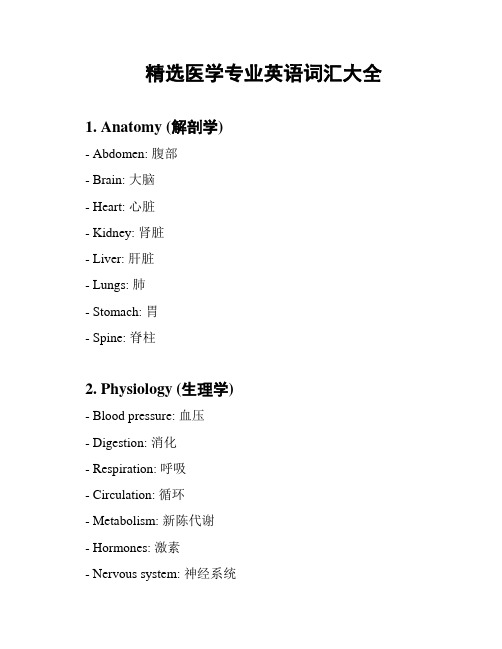
精选医学专业英语词汇大全1. Anatomy (解剖学)- Abdomen: 腹部- Brain: 大脑- Heart: 心脏- Kidney: 肾脏- Liver: 肝脏- Lungs: 肺- Stomach: 胃- Spine: 脊柱2. Physiology (生理学)- Blood pressure: 血压- Digestion: 消化- Respiration: 呼吸- Circulation: 循环- Metabolism: 新陈代谢- Hormones: 激素- Nervous system: 神经系统- Immune system: 免疫系统3. Diseases and Conditions (疾病与病况) - Diabetes: 糖尿病- Cancer: 癌症- Asthma: 哮喘- Hypertension: 高血压- Arthritis: 关节炎- Depression: 抑郁症- Obesity: 肥胖症- Pneumonia: 肺炎4. Medical Procedures (医疗程序)- Surgery: 手术- X-ray: X射线- MRI (Magnetic Resonance Imaging): 磁共振成像- Blood test: 血液检查- Vaccination: 疫苗接种- Dialysis: 透析- Chemotherapy: 化疗5. Medical Specialties (医学专科) - Cardiology: 心脏病学- Dermatology: 皮肤科- Gastroenterology: 胃肠病学- Neurology: 神经学- Psychiatry: 精神病学- Obstetrics and Gynecology: 妇产科- Orthopedics: 骨科- Pediatrics: 儿科6. Medical Instruments (医疗器械) - Stethoscope: 听诊器- Thermometer: 温度计- Sphygmomanometer: 血压计- Scalpel: 解剖刀- Syringe: 注射器- Electrocardiograph: 心电图仪- Ultrasound machine: 超声波机- Endoscope: 内窥镜以上是一份精选医学专业英语词汇大全,涵盖了解剖学、生理学、疾病与病况、医疗程序、医学专科和医疗器械等方面的词汇。
医学英语(山东联盟)知到章节答案智慧树2023年滨州医学院
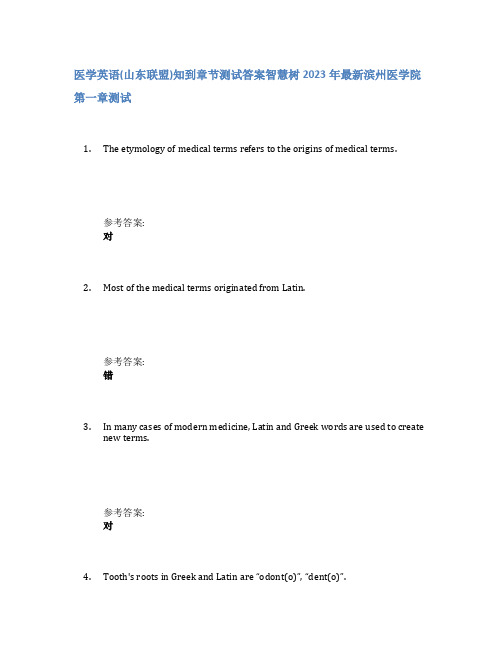
医学英语(山东联盟)知到章节测试答案智慧树2023年最新滨州医学院第一章测试1.The etymology of medical terms refers to the origins of medical terms.参考答案:对2.Most of the medical terms originated from Latin.参考答案:错3.In many cases of modern medicine, Latin and Greek words are used to createnew terms.参考答案:对4.Tooth's roots in Greek and Latin are “odont(o)”, “dent(o)”.参考答案:对5.Stomach's roots in Greek and Latin are“proct(o)”,“rect(o)”.参考答案:错6.What is combining form in Latin for stomach?参考答案:proct(o)-7.The combing form of Rectum in Greek is_____.参考答案:proct(o)8.The suffix “-plasty” in medical terms means______.参考答案:surgical repair9.The prefix“endo-” means_____.参考答案:within10.Which of the following suffix means abnormal condition?参考答案:-osis第二章测试1.People with obsessive compulsive disorder (OCD) are meticulousperfectionists.参考答案:错2.Who is a behaviorist?参考答案:B. F. Skinner3.Cosmetic surgery training is completed through a post-graduate residencyprogram.参考答案:错4.Which makeup tricks can you adopt to make your eyes look bigger?参考答案:Strategic eyeliner5.Empathy is to __________参考答案:share another person’s sadness.6.If your friend is in trouble, which expression conveys empathy?参考答案:I can see how upsetting this is to you. What can I do for you?7.When a doctor communicates with a patient, the positive way is to look intohis /her eyes.参考答案:错8.When a doctor attempts to deliver bad news to the patient try to ____.参考答案:Soften your tone.;Pause briefly.9.The three different types of cloning include .参考答案:Molecular cloning;Organism cloning;Therapeutic cloning10.Molecular cloning focuses on making identical copies of DNA molecules inchromosomes.参考答案:对第三章测试1.In TCM, the understanding of the human body is based on the holisticunderstanding of the universe as described in Daoism.参考答案:对2.The function of yin and yang is guided by the law of unity of the opposites.参考答案:对an transplant does not remove and replace an entire organ, but ratheronly a portion.参考答案:错4.Solid transplantable organs include: heart, lungs, liver, pancreas andintestines.参考答案:对5.The goal for maximum benefit criteria is to maximize the number ofsuccessful transplants.参考答案:对6.In China, when a person dies, the hospital must comply with their writtenwishes regardless of what their family may want.参考答案:错7.Precision medicine is attempting to customize treatments on the basis of aperson's gene tic's or environment.参考答案:对8.Based on the understanding of paragraph 6 of the text, why is it difficult tostore patients' genome data?参考答案:data will also pose a computational challenge.9.Coronary heart disease is closely linked to .参考答案:a diet that is high in unhealthy fats10.Kwashiorkor is mainly caused by inadequate protein intake.参考答案:对第四章测试1.Why does the author say "The human body is a remarkably complex andefficient machine"?____参考答案:It is amazing how well each system functions and coordinates with other systems to enable humans to live and reproduce.2.What can we know about the bones according to the passage?_____参考答案:Bones are united by joints and held together by ligaments.3.Which of the following is True about the heart?____参考答案:There are four chambers which are made up of several layers of smooth muscles.4.Different types of anaesthesia cannot be used in combination at any time.参考答案:错5.When anaesthesia awareness occasion during a surgery, the patient may feelpain or may not feel it.参考答案:对6.Anesthesia awareness only happens with ________.参考答案:general anesthesia7. Prostate cancer is often slowly growing. There may be no symptoms at first,even for years.参考答案:对8.What may be more appropriate for older men where the cancer is notcausing much in symptoms?参考答案:Watchful waiting9.what is uterus?参考答案:子宫10.what is induced abortion?参考答案:引产第五章测试1.Just like a conductor who controls and directs the different musicians in anorchestra, the endocrine system controls and directs other systems in our body, telling them what should be done at what time.参考答案:对2.What are the functions of the thyroid gland?参考答案:Bone growth ;Stimulate cellular metabolism ;Development of the brain and nervous system3.The tip of the heart at the lower edge is called the _______.参考答案:apex4.Which is NOT cardiovascular disease?参考答案:Lupus erythematosus.5.Cortex makes the hormones that control our growth, metabolism, water andmineral balance, sexual maturity, and how we respond to stress.参考答案:对6.The hindbrain consists of the following parts,which are参考答案:Medulla; Pons;Cerebellumrynx is not only the organ of respiratory system but also that of digestivesystem.参考答案:错8.Pharynx contains a pair of vocal cords, which vibrate to make sounds.参考答案:错9.What is the meaning of medical term “Eupnea”?参考答案:normal breathing10.Which of the following combining forms mean lung or of lung?参考答案:pulmon/o第六章测试1. A wide use of passive voice in results section of a research article is for thepurpose of being objective.参考答案:对2.Researchers should present representative data rather than endlesslyrepetitive data in your manuscript.参考答案:对3.Medical record, also known as case history, history and physical notes, healthrecord, and medical chart, is used to describe the systematic documentation of a patient’s medical history and care, time to time within one particularhealth care provider’s ju risdiction.参考答案:对4.Titles have two functions: to identify the main topic or the main point of thearticle and to attract readers.参考答案:对5.If we intend to emphasize the information of other researcher's study in thecitation, the reporting verb tense we usually use is present tense.参考答案:对6.It is not necessary to point out the limitations of your study in the part ofdiscussion of academic writing.参考答案:错7.The structure of discussion is a trapezoid, which means the information indiscussion is from being specific to being general.参考答案:对8.The structure of introduction is a trapezoid, which means the information inintroduction is from being specific to being general.参考答案:错9.The purpose of an abstract is to help your reader understand the paper andget at your main points quickly.参考答案:对10. A summary is to rewrite the original piece.参考答案: 错。
山东大学基础医学院第一轮复试及拟录情况信息公示
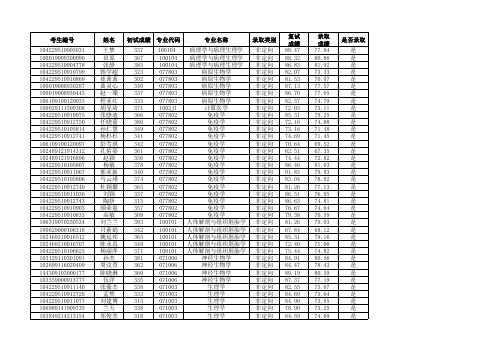
专业名称 病理学与病理生理学 病理学与病理生理学 病理学与病理生理学 病原生物学 病原生物学 病原生物学 病原生物学 病原生物学 计算医学 免疫学 免疫学 免疫学 免疫学 免疫学 免疫学 免疫学 免疫学 免疫学 免疫学 免疫学 免疫学 免疫学 免疫学 免疫学 人体解剖与组织胚胎学 人体解剖与组织胚胎学 人体解剖与组织胚胎学 人体解剖与组织胚胎学 人体解剖与组织胚胎学 神经生物学 神经生物学 神经生物学 神经生物学 生理学 生理学 生理学 生理学 生理学
071003 071010 071010 071010 071010 071010 071010 071010 071009 071009 071009 071009 071009 071009 071009 071009 071009 071009 071009 100706 100706 100706 100706 1001Z1 1001Z1 1001Z1 1001Z1 1001Z1 1001Z2 071007 071007 071007 071007 071007 071007 071007 071007 100104 100104 100104
非定向 非定向 非定向 非定向 非定向 非定向 非定向 非定向 非定向 非定向 非定向 非定向 非定向 非定向 非定向 非定向 非定向 非定向 非定向 非定向 非定向 非定向 非定向 非定向 非定向 非定向 非定向 非定向 非定向 非定向 非定向 非定向 非定向 非定向 非定向 非定向 非定向 非定向 非定向 非定向
73.50 73.19 71.46 81.62 78.24 74.60 70.21 79.03 73.80 76.91 70.33 71.86 81.81 80.57 79.23 75.26 70.71 78.84 78.20 79.57 79.96 80.14 73.45 75.69 76.31 77.55 76.36 76.28 77.93 76.01 75.83 79.41 75.59 64.96 67.81 77.45 72.81 68.40 62.99 58.87
多维医学英语全国统编系列基础医学课后答案

多维医学英语全国统编系列基础医学课后答案1、My home is about _______ away from the school. [单选题] *A. three hundred metreB. three hundreds metresC. three hundred metres(正确答案)D. three hundreds metre2、Helen is new here, so we know _______ about her. [单选题] *A. somethingB. anythingC. everythingD. nothing(正确答案)3、Patrick bought her two handbags as gifts,but _____ of them was her style. [单选题] *A. eitherB. noneC. neither(正确答案)D. all4、I’m still unable to make myself_____in the discussion, which worries me a lot. [单选题]*A.understandB.understood(正确答案)C.understandingD.to be understood5、The train is coming. Be ______! [单选题] *A. careful(正确答案)B. carefullyC. carelessD. care6、Sam is going to have the party ______ Saturday evening. ()[单选题] *A. inB. on(正确答案)C. atD. to7、63.There will be? ? ? ? ??? water on the road after the heavy rain. [单选题] *A.too much(正确答案)B.much tooC.too manyD.many too8、Many people prefer the bowls made of steel to the _____ made of plastic. [单选题] *A. itB. ones(正确答案)C. oneD. them9、Grandfather lives with us. We all _______ him when he gets ill. [单选题] *A. look after(正确答案)B. look atC. look forD. look like10、______ visitors came to take photos of Hongyandong during the holiday. [单选题] *A. ThousandB. Thousand ofC. ThousandsD. Thousands of(正确答案)11、2.I think Game of Thrones is ________ TV series of the year. [单选题] * A.excitingB.more excitingC.most excitingD.the most exciting (正确答案)12、She talks too much; you’ll be glad when you’re free of her. [单选题] *A. 与她自由交谈B. 离开她(正确答案)C. 受她的控制D. 与她在一起13、He prefers to use the word “strange”to describe the way()she walks. [单选题] *A. in which(正确答案)B. by whichC. in thatD. by that14、—______ pencils are these?—They are Tony’s.()[单选题] *A. WhatB. WhereC WhoD. Whose(正确答案)15、Why don’t you _______ the bad habit of smoking. [单选题] *A. apply forB. get rid of(正确答案)C. work asD. graduate from16、12.That is a good way ________ him ________ English. [单选题] * A.to help;forB.helps;withC.to help;with(正确答案)D.helping;in17、I’m looking forward to hearing from you _______. [单选题] *A. recentlyB. soon(正确答案)C. quicklyD. fast18、Our teacher suggested that each of us _____ a study plan for the tong summer vacation. [单选题] *A. make(正确答案)B. madeC. will makeD. would make19、We have _______ a double room with a bath for you in the hotel. [单选题] *A. boughtB. reserved(正确答案)C. madeD. taken20、—Is this Tony’s history book?—No, it isn’t ______.()[单选题] *A. himB. his(正确答案)C. heD. himself21、--What’s your _______, Jim Green?--Jim. [单选题] *A. full nameB. first name(正确答案)C. last nameD. family name22、Mum is ill. I have to _______ her at home. [单选题] *A. look after(正确答案)B. look forC. look outD. look forward to23、_____ the plan carefully,he rejected it. [单选题] *A. To have consideredB.To considerC. Having considered(正确答案)D. Considering24、How beautiful the flowers are! Let’s take some _______. [单选题] *A. photos(正确答案)B. potatoesC. paintingsD. tomatoes25、79.On a ________ day you can see the city from here. [单选题] * A.warmB.busyC.shortD.clear(正确答案)26、How lovely a day,()? [单选题] *A. doesn't itB. isn't it(正确答案)C.shouldn't itD.hasn't it27、The museum is _______ in the northeast of Changsha. [单选题] *A. sitB. located(正确答案)C. liesD. stand28、He’s so careless that he always _______ his school things at home. [单选题] *A. forgetsB. leaves(正确答案)C. putsD. buys29、1.________my father ________ my mother is able to drive a car. So they are going to buy one. [单选题] *A.Neither; norB.Both; andC.Either; orD.Not only; but also(正确答案)30、Mike and his friend are going to the _______ to see the new action movie tonight. [单选题] *A. book shopB. restaurantC. concertD. cinema(正确答案)。
医学英语(整理)PPT

Medical English Listening Training Methods
01 02 03
Active listening
Encouraging active listening skills during Medical English training can improve comprehension. Focusing on key information, asking for clarification, and paraphrasing what has been said can enhance understanding.
Medical English requires clear and precise pronunciation to ensure accurate communication. Practicing proper pronunciation of medical terms and phrases is essential.
医学缩写分类
医学缩写可以根据其用途分为多种类型,如拉丁缩写、英文缩写、 组织机构缩写等。了解这些分类有助于更好地理解和使用医学缩写。
医学缩写规范
医学缩写在使用时需要遵循一定的规范,如首字母大写、使用斜体等。 了解这些规范有助于正确使用医学缩写。
Medical English Grammar
1 2
医学英语句型
Internal Medicine English
诊断术语
掌握常见的内科疾病诊断术语,如高血压、 糖尿病、心脏病等。
病例分析
能够运用医学英语进行病例分析,包括病史 采集、体格检查、实验室检查等。
治疗方案
熟悉内科疾病的治疗方案和药物使用,如药 物治疗、手术治疗、介入治疗等。
(完整版)医学英语(阅读一分册)翻译及答案

Chapter 1Passage 1 Human BodyIn this passage you will learn:1. Classification of organ systems2. Structure and function of each organ system3. Associated medical termsTo understand the human body it is necessary to understand how its parts are put together and how they function. The study of the body's structure is called anatomy; the study of the body's function is known as physiology. Other studies of human body include biology, cytology, embryology, histology, endocrinology, hematology, immunology, psychology etc.了解人体各部分的组成及其功能,对于认识人体是必需的。
研究人体结构的科学叫解剖学;研究人体功能的科学叫生理学。
其他研究人体的科学包括生物学、细胞学、胚胎学、组织学、内分泌学、血液学、遗传学、免疫学、心理学等等。
Anatomists find it useful to divide the human body into ten systems, that is, the skeletal system, the muscular system, the circulatory system, the respiratory system, the digestive system, the urinary system, the endocrine system, the nervous system, the reproductive system and the skin. The principal parts of each of these systems are described in this article.解剖学家发现把整个人体分成骨骼、肌肉、循环、呼吸、消化、泌尿、内分泌、神经、生殖系统以及感觉器官的做法是很有帮助的。
《基础医学英语》课件

医学文献的文体特点
理解文章结构
在阅读医学文献时,需要理解文章的结构,特别是标题、摘要和引言等部分。这些部分通常包含了文章的主要观点和研究背景等信息。
对比不同文献
阅读多篇医学文献时,需要对比不同文献的观点和研究方法,以获得更全面和深入的理解。
笔记整理
阅读医学文献需要做好笔记整理,记录重要的观点、数据和研究方法等信息,以便后续复习和引用。
医学文献中通常包含了很多图表和数据,需要仔细阅读以理解其中的含义和相关性。
阅读完医学文献后,需要对文献进行评价和总结,分析其优点和不足之处,以及在实践中的应用价值。
阅读医学文献的步骤和策略
阅读标题和摘要
仔细阅读图表
总结和评价
通读全文
医学英语写作
03
清晰准确
01
医学英语写作必须清晰准确地表达思想和概念,避免使用歧义或模棱两可的语言。
医学英语词汇学习方法
医学文献阅读
02
专业化术语
医学文献中使用了大量的专业化和术语,包括医学和生物学术语,这些术语具有特定的含义和用法。
科学性和客观性
医学文献以科学实验和数据为依据,具有很强的客观性和科学性。语言表述上通常采用被动语态和复杂句型,以强调客观性和准确性。
结构化的写作风格
医学文献通常采用结构化的写作风格,包括标题、摘要、引言、方法、结果和讨论等部分。
医学论文摘要写作规范
结构完整
摘要应包括研究目的、方法、结果和结论等主要部分,确保信息的完整性。
突出重点
摘要应突出研究的核心内容和创新点,强调研究的重要性和价值。
精炼简洁
摘要应遵循精炼简洁的原则,用最少的文字准确传达信息。
THANK YOU.
谢谢您的观看
山东大学2018年齐鲁医学院招生目录_山东大学考研网

学
1.细胞生物学
③930 药理学
2.分子生物学
医学类:
1.内科学
2.外科学
①501 英语
同等学力加试:
②682 生理学(基础 1.内科学
课)
2.外科学
③939 医学心理学
①501 英语
同等学力加试任选两
②689 病理生理学(基 门:
础课)
1.医学分子生物学
③01 方向:931 内科 2.肿瘤病理学
学(心血管病);
徐欣
①501 英语
同等学力加试:
刘东旭
②718 口腔基础综合
1.口腔组织病理学
葛少华
③01 方向:953 口腔 2.口腔解剖生理学
颌面外科学
在职申请/攻读硕士
02 方向:965 口腔正 学位加试任选一门。
畸学
不接受跨学科报考。
03 方向:964 口腔内
科学
马伟
①501 英语
同等学力加试:
吕明
②01-04 方向:693 卫 1.社会医学
统计学;
元统计学或儿少卫生学
100402 劳动卫生与环境卫生学 01 职业卫生与职业医学
1004Z1 卫生检验学 01 分子病毒学、病毒学检验
文章来源:文彦考研
③01-06 方向:958 流
行病学
07 方向:958 流行病
学或 959 多元统计学
王志萍
①501 英语
础课)
1.医学分子生物学
③01 方向:950 小儿 2.肿瘤病理学
外科学
3.医学免疫学
02 方向:941 儿科学
①501 英语
同等学力加试任选两
②684 医学分子生物 门:
新编基础医学英语答案部分

新编基础医学英语答案部分2the physical, mental, emotional, social and spiritual aspects of health. It focuses on educationand responsibility for personal efforts to achieve balance and well being.2. Holistic Health is a total approach to life both in physical and spiritual terms. The goal of holistic healing is to achieve maximum body function, where individual body parts are functioning the very best that is possible by themselves.3. In mainstream medicine, a holistic approach generally means a more inclusive approach to a person's health, one that includes the patient's social and cultural situation as well as her orhis illness.4. Holistic medicine can involve the use of conventional and alternative therapies but focuses mostly on lifestyle changes.5. Holistic medicine has its roots in several ancient healing traditions that stress healthy living and being in harmony with nature. Socrates promoted a holistic approach. Plato was another advocate of holism, advising doctors to respect the relationship between mind and body. Hippocrates, emphasized the body's ability to heal itself and cautioned doctors not tointerfere with that process. It was not until 1926, however, that Jan Christian Smuts coinedthe term "holism", which has given us the more integrated concept of psychosomaticmedicine now known as holistic medicine. In the 1970s, "holistic" became a more common term.II1. Holistic medicine2. Holistic health3. homeostasis4. lifestyle changes5. Holistic medicineTranslationI1. 整体健康指身体和精神两个方面都健康。
医学英语基础医学
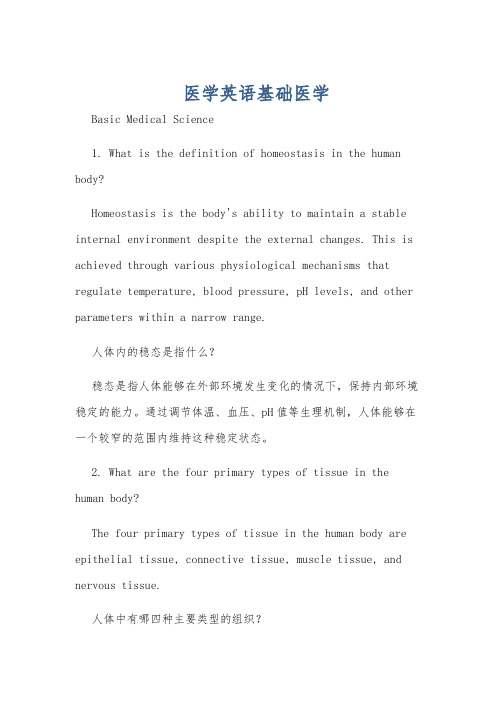
医学英语基础医学Basic Medical Science1. What is the definition of homeostasis in the human body?Homeostasis is the body's ability to maintain a stable internal environment despite the external changes. This is achieved through various physiological mechanisms that regulate temperature, blood pressure, pH levels, and other parameters within a narrow range.人体内的稳态是指什么?稳态是指人体能够在外部环境发生变化的情况下,保持内部环境稳定的能力。
通过调节体温、血压、pH值等生理机制,人体能够在一个较窄的范围内维持这种稳定状态。
2. What are the four primary types of tissue in the human body?The four primary types of tissue in the human body are epithelial tissue, connective tissue, muscle tissue, and nervous tissue.人体中有哪四种主要类型的组织?人体中的四种主要类型的组织包括上皮组织、结缔组织、肌肉组织和神经组织。
3. What is the function of the respiratory system?The respiratory system is responsible for the exchangeof oxygen and carbon dioxide between the body and the environment. It also helps regulate the body's pH and plays a role in vocalization and olfaction.呼吸系统的功能是什么?呼吸系统负责人体与环境之间的氧气和二氧化碳交换。
- 1、下载文档前请自行甄别文档内容的完整性,平台不提供额外的编辑、内容补充、找答案等附加服务。
- 2、"仅部分预览"的文档,不可在线预览部分如存在完整性等问题,可反馈申请退款(可完整预览的文档不适用该条件!)。
- 3、如文档侵犯您的权益,请联系客服反馈,我们会尽快为您处理(人工客服工作时间:9:00-18:30)。
Para.3 Question: 4. What are the basic components of neurons ? ( nucleolus n. 核仁 / nucleus 细胞核 ) Para. 4 Question: 5. What are the functions of dendrites ? dendritic spinules 微刺 dendritic zone 树突区
Fundamental Medical English
《基础医学英立
Teaching Set-up
This course is conducted on a one-unit-a week basis preceded by a general introduction to medical English in the first week of the school term. Units chosen are as follows:
Nervous System Organization
Understanding the Text
Part I General Introduction (para.1-5) Para. 1 Questions: 1.What does this paragraph mainly talk about ? components and functions of nervous system 2. Explain the following: neurons/nerve cells/nuclei/ganglia/neuroglia
Unit 8 The Immune System Unit 11 Cloning and Genes Unit 12 Pathology Unit 13 Medication Unit 14 Microbiology Unit 15 A Survey of Medicine
Routines for each unit
finely tuned---- 调节精细的 tune v. 调节, 调整; 使和谐, 使一致 e.g. The colors are perfectly tuned to each other. 颜色很协调。 The machine has just been tuned. 机器刚调整过。 Para. 9 bundled nerve cell processes----成束的神经细胞突起
Unit 1 Holism
Unit 2 The Musculoskeletal System Unit 3 The Nervous System Unit 4 The Circulatory System Unit 5 The Respiratory System Unit 6 The Digestive System Unit 7 The Urinary System
Diencephalon
Hypothalamus Thalamus Gray matter
Cerebrum
White matter
Basal ganglia
Part III The Peripheral Nervous System (para. 10 )
The four groups of nerves that branch from the cervical, thoracic, lumbar, and sacral regions of the spinal cord are called the peripheral nerves. The peripheral nervous system includes all the nerves and ganglia found outside the brain and spinal cord, more specifically, the cranial, spinal and autonomic nerves. axonal/dendritic processes 轴突/树突 (P40)
cerebrum
cerebellum
pituitary
hypothalamus
Brain stem
Medulla oblongata Brain Stem
The pons
The midbrain
Cerebellum
Gray matter White matter
Brain
1. Word Formation 2. Group Discussion 3. Background Knowledge 4. Understanding the Text 5. Assignment
Unit 3 The Nervous System
Word Formation
neur/o- 神经 necle/o 核 gangli/o-, ganglion/o- 神经节 gli/o- 胶, 胶质 ( neuron, neurofibril ) ( nucleus ) ( ganglia ) ( neuroglia )
Nerves are divided into sensory nerves, motor nerves, and mixed nerves. Sensory nerves receive impulses from the various systems of the body, such as the eyes, ears, nose, tongue and skin. And bring them to the CNS, while motor nerves conduct impulses from the CNS to muscles and glands. Therefore, sensory nerves are also called afferent nerves, and motor nerves are efferent nerves. Mixed nerves are composed both of sensory and motor nerves.
1. What do you know about nervous system ? 2. Why is the nervous system important to us ?
Background Knowledge
Nervous system The system of cells, tissues, and organs that regulates the body's responses to internal and external stimuli. In vertebrates it consists of the brain, spinal cord, nerves, ganglia, and parts of the receptor and effector organs. There are probably more than 100000 million nerve cells in the body. The nervous system is the sum total of all these, together with their nerve fibers, which spread throughout the body, and the various supporting components of nervous tissue.
medull/o 髓质
( medulla ) ( cytoplasm )
cyt/o, -cyte 细胞
mito- 线
( mitochondrial )
-ule (使小后缀) ( spinule, tubule ) fibr/o- 纤维 ( neurofibril )
Group Discussion
Para. 2 Question: 3.What are the functions of neurons and neuroglia ?
Difficult Points variety----n. the quality of not being the same 多样化, 变化 e.g. 1) His writing lacks variety. (文体缺乏变化) 2) give variety to the programme ( 使节目丰富多彩) 3) Neurons are constructed in various varieties. 神经元的构成是多样的。
Para. 5 Question: 6. What consists of the cytoplasm of axon ? Difficult Points process----n. projecting part of the body 突起 e.g. articulating process 关节突 ciliary processes 睫状突 mastoid process 乳突 transverse process 横突 xiphoid process 剑突
Difficult Points
cerebral cortex integration/integrate 综合; 整合 process----n. technical or scientific action 方法 e.g. A process for testing serum samples has been developed in the research laboratory. 实验室研发了一种检测血清样本的新方法。
Like a central processing unit, the nervous system regulates and coordinates many body activities. It is divided into the central nervous system (CNS), including the brain and spinal cord, and the peripheral nervous system (PNS), composed of nerves, ganglia, and receptors.
